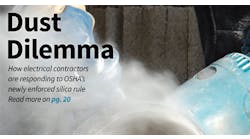When it comes to providing suitable power, grounding, communications, and environmental control for a facility that has significant amounts of susceptible electronic equipment, there are obviously many factors to keep in mind. Although each installation has its own unique requirements, there are many characteristics common to all projects.
To help you or your client make more informed decisions on designing, installing, or retrofitting a distribution system that powers susceptible electronic equipment, check out the following guidelines, derived from practical working checklists used by specialists in power quality auditing and compiled in the book “Quality Power for Sensitive Electronic Equipment,” written by the editors of EC&M and edited by the late Ray Waggoner.
Continuity of processing operations. Before purchasing equipment for electronic data processing, process control, communications, instrumentation, or similar applications, you should first study the operations planned for the facility. This will help you develop answers to the following questions:
-
What length of downtime can the facility tolerate? Many operations can withstand 5 to 20 milliseconds of downtime by their internal ride-through capacity.
-
How frequently can such downtime occur? Some locations tolerate one to three power outages per year, but require some additional protection if occurrences total several times a month (20 to 25 times a year).
-
Are momentary interruptions acceptable? Some hardware and software systems provide for “hold and store” methods of preserving data in case of momentary interruptions.
-
What is the cost in revenue of interruptions and downtime in terms of lost data, “reboot” time, damaged hardware or software, corrupted intercommunications, and lost processing throughput? The cost of interruption may justify investment in power and grounding improvements.
-
What power quality-related events will interrupt data input, processing, and useful output? For example, even with continuous power to processing hardware, interruption of a separately powered process cooling plant could halt operations. While water-cooled processors may be able to withstand a few degrees of temperature change, they cannot stand loss of circulation.
-
Are operations dependent on communication lines that also require continuity of electrical power? In other words, you must decide whether or not a telephone system should be on conditioned power.
-
Is the backup or alternate site operated from the same power source, and are its communications also dependent on electrical power? You should avoid dependency on common facilities (the same power poles, side of the street, or underground trench) whenever possible.
Facility location considerations. Although some factors are out of your control, you must think about how they may affect operation of your facility. To help sort things out, consider the following:
-
Will the site be subject to natural hazards? Storm damage from wind, rain, snow, sleet, ice, lightning, flooding, tidal waves, moving ice, fire, earthquakes, and mud slides are some items that could affect operations.
-
Will the site be subject to man-made hazards? Vandalism, sabotage, malicious mischief, arson, vehicle collisions, riots, insurrections, or even war (in extreme circumstances) are all possible causes of interruptions.
-
Will the facility be subject to offsite damage to support services? Power and communications as well as gas, water, and sewer lines may be vulnerable.
-
Will the site be subject to lightning and excavation damage? Even if installed underground, services damage may occur. If there is more than one power feeder and communications cable to the building, each should be placed in a separate trench.
-
Are the local electrical safety and other building codes overly restrictive in permitted construction materials and assembly methods? Unnecessary restrictions can dictate the use of expensive labor-intensive construction materials and assembly methods, which can increase initial installation costs and continuing maintenance expenses.
Commercial power considerations. Facilities having high percentages of susceptible electronic equipment are extremely dependent on a source of dependable electric power. As such, you should analyze the service record of the utility serving the existing or proposed site. Here are some questions you should pose to your local utility:
-
What are its recorded power outage and disturbance records? Be careful here: Some utilities record only “outages,” which can be defined as an interruption of power lasting more than 5 minutes. Intermittent breaker operations of 5 to 20 Hz might not be normally recorded. Therefore, make sure you ask for the number of breaker operations counted on the facility's feeder per quarter per year.
-
How does its power quality history compare with other utilities serving other sites? Use the site analysis surveys offered by site preparation and coordination companies. These studies indicate what items are typically measured and reported.
-
What are the power quality records and system operating performances of other end-users in the area? Make sure you compare each history with the different types of power conditioning devices in use.
-
What support does the local electric utility provide? Many utilities offer customers a variety of programs for analysis, design, and equipment selection to help enhance power and grounding infrastructure. This may even include equipment leasing or provision of premium quality power supplied directly from a utility-owned power-conditioning substation.
-
What are the available utility options for normal and backup feeders? Depending on the facility location, the utility can provide a dual-feeder service, which can eliminate expensive long-term power support equipment such as UPS systems, batteries, and engine generators.
-
Can the utility provide separate distribution lines fed from separate substations? This allows for utility service maintenance and accidental outage on one feeder without sacrificing continuous power. You should use the same strategy for telephone and data communications cables.
-
Is the cost of electricity excessively high at the facility site? Here, you should compare the electricity costs at different locations. Find out if there are demand charges and/or low power factor penalties. In other words, find out what effect will system efficiency have on actual operating dollars.
Coordination and planning with CPU vendor.. The characteristics of solid-state electronic equipment vary per manufacturer. Therefore, it's important that you have specific performance data on the proposed equipment. The following is a list of things you should do with the selected or prospective CPU vendor:
-
Obtain general specifications for overall power quality, grounding, and communication installation.
-
Obtain an equipment list that contains specifications on line frequency (with tolerance limits and maximum rate-of-change); line voltage(s), phases, nominal value(s) with upper and lower limits; load characteristics for each EDP unit, including kVA, kW, phases, and amperes on each phase for both normal and starting; combined system kVA, kW, power factor, amperes (both rms and peak), and heat output in BTU/hr or equivalent metric units; maximum starting inrush currents for units having the 10 largest values; and site preparation and installation planning manuals.
-
Discuss the proposed system to determine the CPU characteristics. How well will it operate, and how will it fail? Concentrate on the general specifications in determining specific areas of power and grounding enhancement or failure protection, in accordance with IEEE 1100 (the Emerald Book).
-
Determine the existing or anticipated conditions to be encountered at the facility and obtain an agreement from the vendor on the protection that will provide the best operating integrity for the system. Make sure you discuss the following items:
-
Power system quality: Providing a constant source of relatively undisturbed electrical power of adequate load capability, suited for the loads, and maintained within limits set for nominal values of line voltage, frequency, waveshape distortion (harmonics), voltage sags, impulse surges, transients, electrical noise, and other attributes of the power source.
-
Solid-state electronic equipment susceptibility: Equipment should withstand the disturbances and aberrations of electrical environments in which it is expected to operate, especially the power source.
-
Compatibility of load equipment and power sources: This includes harmonizing their respective characteristics, including interactions between electronic equipment and their power sources. Where source and load both consist of high, dynamic, internal impedances, the risk of distorting the electrical waveshape is high. These distortions can easily lead to power conditioning applications causing more interference than they are supposed to remove.
-
Grounding, referencing, and shielding: Provide equipotential signal referencing and shielding that is compatible with grounding requirements for safety.
-
Power distribution: Avoid unwanted coupling by employing isolation and coordination of power circuits and their respective grounds.
-
Conductor sizing and overcurrent protection: Protection from faults and overloads, with special attention to the effects of harmonic load currents.
-
Lightning and surge suppression/protection: Providing lightning, power switching, and electrostatic discharge (ESD) protection system.
-
-
Discuss with the vendor any conditions that will make the system fail. The definition of “power interruption” involves time duration. The fact that single-phase AC line voltage varies sinusoidally and passes through zero twice each cycle does not mean there is a power failure every 1/120th second. Electronic equipment is typically designed to store enough energy in its DC filtering elements to ride through each AC zero crossing plus some additional time. Most electronic equipment can withstand a one-half cycle interruption without disturbing the filtered and regulated DC power supplied to logic circuits.
-
Make sure those responsible for electrical wiring and apparatus installation are reasonably responsive to the solid-state vendor and end-user's needs. They should be adequately trained and have the necessary understanding to work cooperatively with the end-user to solve power quality-related problems. In addition, they must also be able to merge noise-control procedures with their construction practices.
Remember, the most important needs of susceptible electronic equipment are a dependable source of electrical energy, a grounding system that provides a stable platform for consistent operation, and protection against transient surges. You must address these factors as well as others at several different levels if your facility operation efforts are to be truly successful.
Next month, we'll cover design of the power system that will serve the susceptible electronic equipment, matching system power requirements to power conditioning alternatives, grounding for consistent noise suppression, redundancy requirements, data communications protection, and lightning protection.


